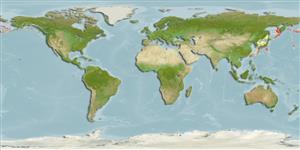>
Perciformes/Cottoidei (Sculpins) >
Liparidae (Snailfishes)
Etymology: Careproctus: Greek, kara = face + Greek, proktos = anus (Ref. 45335); lycopersicus: Named for the tomato plant, Solanum lycopersicum, meaning ‘wolf peach'; referring to its typically bright red tomato-like coloration..
Environment: milieu / climate zone / depth range / distribution range
Écologie
marin bathydémersal; profondeur 397 - 1157 m (Ref. 91047). Temperate
North Pacific: Bering Sea and the eastern Aleutian Islands.
Taille / Poids / Âge
Maturity: Lm ? range ? - ? cm
Max length : 13.3 cm TL mâle / non sexé; (Ref. 91047); 17.2 cm TL (female)
Description synthétique
Morphologie | Morphométrie
Rayons mous dorsaux (Total): 42-45; Rayons mous anaux: 34 - 38; Vertèbres: 45 - 50. This species is distinguished from its congeners by the following characters: premaxilla and dentary with broad rows of strongly trilobed teeth (vs. simple or weakly trilobed teeth on both jaws); the large gill opening extends ventrally to pectoral rays 8-12 (vs. smaller above the pectoral fin or extending to less than five pectoral-fin rays); large pelvic disk greater or equal 30% head length (vs. smaller pelvic disk, < 25% HL); most similar to C. ovigerus, which can be distinguished from C. lycopersicus by its simple, canine teeth on both jaws, and to C. kamikawai, which is distinguished by its subterminal mouth, slight dorsal-fin lobe, black peritoneum, smaller pelvic disc, slender caudal base, and more anterior position of the pelvic disc, anus, and anal-fin origin (Ref. 91047).
One 11.6 cm TL ripe male and female specimens were examined: the smallest female with yolked eggs was 14.9 cm (UW 119817). For the ripe females, at least two sizes of eggs were present, yolked eggs were 3.5 mm in diameter and smaller white eggs had diameters of 0.5-1.5 mm (Ref. 91047).
Life cycle and mating behavior
Maturité | Reproduction | Frai | Œufs | Fécondité | Larves
Orr, J.W., 2012. Two new species of snailfishes of the genus Careproctus (Scorpaeniformes: Liparidae) from the Bering Sea and Eastern North Pacific Ocean, with a redescription of Careproctus ovigerus. Copeia 2012(2):257-265. (Ref. 91047)
Statut dans la liste rouge de l'IUCN (Ref. 130435)
Menace pour l'homme
Harmless
Utilisations par l'homme
Plus d'informations
PaysZones FAOÉcosystèmesOccurrencesIntroductionsStocksÉcologieRégime alimentaireÉléments du régime alimentaireConsommation alimentaireRation
Noms communsSynonymesMétabolismePrédateursÉcotoxicologieReproductionMaturitéFraiRassemblement de ponteFéconditéŒufsDéveloppement de l'œuf
Taille/ÂgeCroissanceLongueur-poidsLongueur-longueurFréquences de longueursMorphométrieMorphologieLarvesDynamique des populations larvairesRecrutementAbondanceBRUVS
RéférencesAquacultureProfil d'aquacultureSouchesGénétiqueElectrophoresesHéritabilitéPathologiesTraitementNutrientsMass conversion
CollaborateursImagesStamps, Coins Misc.SonsCiguateraVitesseType de nageSurface branchialeOtolithesCerveauxVision
Outils
Articles particuliers
Télécharger en XML
Sources Internet
Estimates based on models
Preferred temperature (Ref.
123201): 2 - 3.5, mean 3.3 °C (based on 22 cells).
Phylogenetic diversity index (Ref.
82804): PD
50 = 0.5000 [Uniqueness, from 0.5 = low to 2.0 = high].
Bayesian length-weight: a=0.00447 (0.00204 - 0.00980), b=3.17 (2.99 - 3.35), in cm total length, based on LWR estimates for this Genus-body shape (Ref.
93245).
Niveau trophique (Ref.
69278): 3.2 ±0.5 se; based on size and trophs of closest relatives
Résilience (Ref.
120179): Haut, temps minimum de doublement de population inférieur à 15 mois (Preliminary K or Fecundity.).
Fishing Vulnerability (Ref.
59153): Low vulnerability (10 of 100).
